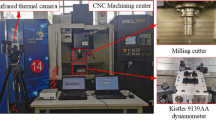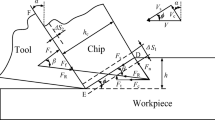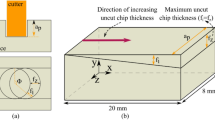Abstract
Complex curved thin-walled structures, typically produced by multi-axis milling, are highly susceptible to deformation induced by residual stress. It is, therefore, that there is a considerable amount of research on developing predictive models for machining-induced residual stress. However, these developed models for residual stress prediction mainly focus on turning and three-axis milling. In the current study, a hybrid model combining experimental results and a finite element (FE) model is established to predict the residual stress profile of Ti-6Al-4 V titanium alloy for multi-axis milling. The residual stress profile is fitted by using the hyperbolic tangent function with the firefly algorithm (FA) based on the simulation and experiment. The R2 values change from 85.3 to 99.1% in the σx direction and change from 80.7 to 98.1% in the σy direction, which indicates a high fitting accuracy. The radial basis function (RBF) neural network is employed to establish the association between the process parameters and the model coefficients. Thus, the residual stress profile can be expressed by the cutting speed, feed rate, and inclination angle. And the prediction accuracy is verified to achieve 92.7% and 91.4% in the σx and σy directions, respectively. The effects of the cutting speed, feed rate, and inclination angle on surface residual stress and response depth are investigated. The findings demonstrate a strong nonlinear connection between process parameters and surface residual stress. The proposed hybrid prediction model of residual stress can be used for further machining optimization of complex curved thin-walled structures.
















Similar content being viewed by others
Availability of data and materials
All data and materials used or analyzed during the current study are included in this manuscript.
References
Akhtar W, Lazoglu I, Liang SY (2022) Prediction and control of residual stress-based distortions in the machining of aerospace parts: a review. J Manuf Process 76:106–122. https://doi.org/10.1016/j.jmapro.2022.02.005
Xu L, Huang C, Li C, Wang J, Liu H, Wang X (2021) An improved case based reasoning method and its application in estimation of surface quality toward intelligent machining. J Intell Manuf 32:313–327. https://doi.org/10.1007/s10845-020-01573-2
Zhao X, Zheng L, Wang Y, Zhang Y (2022) Services-oriented intelligent milling for thin-walled parts based on time-varying information model of machining system. Int J Mech Sci 219:107125. https://doi.org/10.1016/j.ijmecsci.2022.107125
Imad M, Hopkins C, Hosseini A, Yussefian, N Z, Kishawy, H A (2021) Intelligent machining: a review of trends, achievements and current progress. Int J Comput Integr Manuf 1–29. https://doi.org/10.1080/0951192x.2021.1891573
Zhou J, Ren J, Tian W (2017) Grey-RBF-FA method to optimize surface integrity for inclined end milling Inconel 718. Int J Adv Manuf Technol 91:2975–2993. https://doi.org/10.1007/s00170-016-9897-1
Madariaga A, Kortabarria A, Hormaetxe E, Garay A, Arrazola PJ (2016) Influence of tool wear on residual stresses when turning Inconel 718. Procedia CIRP 45:267–270. https://doi.org/10.1016/j.procir.2016.02.359
Zlatin N, Field M (1973) Procedures and precautions in machining titanium alloys. Titan Sci Technol 489–504. https://doi.org/10.1007/978-1-4757-1346-6_37
Sun J, Guo YB (2009) A comprehensive experimental study on surface integrity by end milling Ti–6Al–4V. J Mater Process Technol 209:4036–4042. https://doi.org/10.1016/j.jmatprotec.2008.09.022
Ullah I, Zhang S, Waqar S (2022) Numerical and experimental investigation on thermo-mechanically induced residual stress in high-speed milling of Ti-6Al-4V alloy. J Manuf Process 76:575–587. https://doi.org/10.1016/j.jmapro.2022.02.039
Ratchev SM, Afazov SM, Becker AA, Liu S (2011) Mathematical modelling and integration of micro-scale residual stresses into axisymmetric FE models of Ti6Al4V alloy in turning. CIRP J Manuf Sci Technol 4:80–89. https://doi.org/10.1016/j.cirpj.2011.03.002
Holmberg J, Prieto JMR, Berglund J, Sveboda A, Jonsén P (2018) Experimental and PFEM-simulations of residual stresses from turning tests of a cylindrical Ti-6Al-4V shaft. Procedia CIRP 71:144–149. https://doi.org/10.1016/j.procir.2018.05.087
Ulutan D, Özel T (2013) Multiobjective optimization of experimental and simulated residual stresses in turning of nickel-alloy IN100. Mater Manuf Process 28:835–841. https://doi.org/10.1080/10426914.2012.718474
Arısoy YM, Özel T (2015) Prediction of machining induced microstructure in Ti–6Al–4V alloy using 3-D FE-based simulations: effects of tool micro-geometry, coating and cutting conditions. J Mater Process Technol 220:1–26. https://doi.org/10.1016/j.jmatprotec.2014.11.002
Shan C, Zhang M, Zhang S, Dang J (2020) Prediction of machining-induced residual stress in orthogonal cutting of Ti6Al4V. Int J Adv Manuf Technol 107(5):2375–2385. https://doi.org/10.1007/s00170-020-05181-5
Ulutan D, Özel T (2013) Determination of tool friction in presence of flank wear and stress distribution based validation using finite element simulations in machining of titanium and nickel based alloys. J Mater Process Technol 213:2217–2237. https://doi.org/10.1016/j.jmatprotec.2013.05.019
Sahu NK, Andhare AB (2019) Prediction of residual stress using RSM during turning of Ti–6Al–4V with the 3D FEM assist and experiments. SN Appl Sci 1:1–14. https://doi.org/10.1007/s42452-019-0809-5
Arrazola PJ, Özel T, Umbrello D, Davies M, Jawahir IS (2013) Recent advances in modelling of metal machining processes. CIRP Ann - Manuf Technol 62:695–718. https://doi.org/10.1016/j.cirp.2013.05.006
Capello E (2005) Residual stresses in turning: part I: influence of process parameters. J Mater Process Technol 160:221–228. https://doi.org/10.1016/j.jmatprotec.2004.06.012
El-Axir MH (2002) A method of modeling residual stress distribution in turning for different materials. Int J Mach Tools Manuf 42:1055–1063. https://doi.org/10.1016/S0890-6955(02)00031-7
Yang D, Liu Z, Ren X, Zhuang P (2016) Hybrid modeling with finite element and statistical methods for residual stress prediction in peripheral milling of titanium alloy Ti-6Al-4V. Int J Mech Sci 108:29–38. https://doi.org/10.1016/j.ijmecsci.2016.01.027
Wang J, Zhang D, Wu B, Luo M (2017) Numerical and empirical modelling of machining-induced residual stresses in ball end milling of Inconel 718. Procedia CIRP 58:7–12. https://doi.org/10.1016/j.procir.2017.03.177
Ulutan D, Arisoy YM, Özel T, Mears L (2014) Empirical modeling of residual stress profile in machining nickel-based superalloys using the sinusoidal decay function. Procedia CIRP 13:365–370. https://doi.org/10.1016/j.procir.2014.04.062
Zhou J (2018) Modeling of cutting residual stress and distortion prediction for machining thin-walled structure. Dissertation, Northwestern Polytechnical University (in Chinese). https://doi.org/10.27406/d.cnki.gxbgu.2018.000039
Arısoy YM, Guo C, Kaftanoğlu B, Özel T (2016) Investigations on microstructural changes in machining of Inconel 100 alloy using face turning experiments and 3D finite element simulations. Int J Mech Sci 107:80–92. https://doi.org/10.1016/j.ijmecsci.2016.01.009
Ee KC, Dillon OW Jr, Jawahir IS (2005) Finite element modeling of residual stresses in machining induced by cutting using a tool with finite edge radius. Int J Mech Sci 47:1611–1628. https://doi.org/10.1016/j.ijmecsci.2005.06.001
Ren J, Cai J, Zhou J, Shi K, Li X (2018) Inverse determination of improved constitutive equation for cutting titanium alloy Ti-6Al-4V based on finite element analysis. Int J Adv Manuf Technol 97:3671–3682. https://doi.org/10.1007/s00170-018-2178-4
Wang Q, Liu Z, Yang D, Mohsan AUH (2017) Metallurgical-based prediction of stress-temperature induced rapid heating and cooling phase transformations for high speed machining Ti-6Al-4V alloy. Mater Des 119:208–218. https://doi.org/10.1016/j.matdes.2017.01.076
Pan Z, Liang SY, Garmestani H, Shih D, Hoar E (2019) Residual stress prediction based on MTS model during machining of Ti-6Al-4V. Proc Inst Mech Eng Part C J Mech Eng Sci 233:3743–3750. https://doi.org/10.1177/0954406218805122
Grove T, Köhler J, Denkena B (2014) Residual stresses in milled β-annealed Ti6Al4V. Procedia CIRP 13:320–326. https://doi.org/10.1016/j.procir.2014.04.054
Jiang W, Chen W, Woo W, Tu S, Zhang X, EM V, (2018) Effects of low-temperature transformation and transformation-induced plasticity on weld residual stresses: numerical study and neutron diffraction measurement. Mater Des 147:65–79. https://doi.org/10.1016/j.matdes.2018.03.032
Cui X, Wu X, Wan M, Ma B, Zhang Y (2019) A novel constitutive model for stress relaxation of Ti-6Al-4V alloy sheet. Int J Mech Sci 161:105034. https://doi.org/10.1016/j.ijmecsci.2019.105034
Denkena B, Nespor D, Böß V, Köhler J (2014) Residual stresses formation after re-contouring of welded Ti-6Al-4V parts by means of 5-axis ball nose end milling. CIRP J Manuf Sci Technol 7:347–360. https://doi.org/10.1016/j.cirpj.2014.07.001
Wan M, Ye XY, Yang Y, Zhang W-H (2017) Theoretical prediction of machining-induced residual stresses in three-dimensional oblique milling processes. Int J Mech Sci 133:426–437. https://doi.org/10.1016/j.ijmecsci.2017.09.005
Nespor D, Denkena B, Grove T, Böß V (2015) Differences and similarities between the induced residual stresses after ball end milling and orthogonal cutting of Ti–6Al–4V. J Mater Process Technol 226:15–24. https://doi.org/10.1016/j.jmatprotec.2015.06.033
Yang X-S, He X (2013) Firefly algorithm: recent advances and applications. arXiv Prepr arXiv13083898 1:36–50. https://doi.org/10.1504/IJSI.2013.055801
Jain AK, Mao J, Mohiuddin KM (1996) Artificial neural networks: a tutorial. Computer (Long Beach Calif) 29:31–44. https://doi.org/10.4018/978-1-4666-5888-2.ch626
Liang X, Liu Z, Wang B, Hou X (2018) Modeling of plastic deformation induced by thermo-mechanical stresses considering tool flank wear in high-speed machining Ti-6Al-4V. Int J Mech Sci 140:1–12. https://doi.org/10.1016/j.ijmecsci.2018.02.031
Funding
This work is supported by the National Natural Science Foundation of China (Grant No. 52075451), the National Science and Technology Major Project (Grant No. J2019-VII-0001–0141), the Aeronautical Science Foundation of China (Grant No. 2019ZE053008), Science Center for Gas Turbine Project (P2022-B-IV-012–001), and the China Postdoctoral Science Foundation (Grant No. 2020M683551).
Author information
Authors and Affiliations
Contributions
Zongyuan Wang: methodology, investigation, formal analysis, and writing draft. Jinghua Zhou: project administration, formal analysis, review, and editing. Junxue Ren: supervision and review. Ailing Shu: review.
Corresponding author
Ethics declarations
Ethics approval and consent to participate
The manuscript is approved by all authors for publication. This manuscript is original, and the entire paper or any part of its content has never been published in other journals. The data and results are true and clear. We guarantee the transparency and objectivity of research and strictly abide by the ethical and professional standards of the industry. All the authors listed agree to participate in this manuscript.
Consent for publication
All co-authors agree to publish the version of this work in The International Journal of Advanced Manufacturing Technology.
Competing interests
The authors declare no competing interests.
Additional information
Publisher's note
Springer Nature remains neutral with regard to jurisdictional claims in published maps and institutional affiliations.
Rights and permissions
Springer Nature or its licensor (e.g. a society or other partner) holds exclusive rights to this article under a publishing agreement with the author(s) or other rightsholder(s); author self-archiving of the accepted manuscript version of this article is solely governed by the terms of such publishing agreement and applicable law.
About this article
Cite this article
Wang, Z., Zhou, J., Ren, J. et al. Hybrid prediction model for residual stress profile induced by multi-axis milling Ti-6Al-4 V titanium alloy combined finite element with experiment. Int J Adv Manuf Technol 126, 4495–4511 (2023). https://doi.org/10.1007/s00170-023-11406-0
Received:
Accepted:
Published:
Issue Date:
DOI: https://doi.org/10.1007/s00170-023-11406-0




